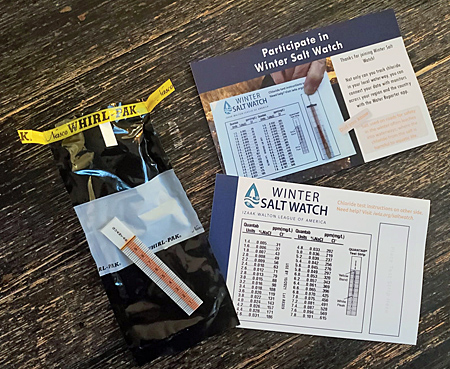Salt Watch
To better understand how salt affects aquatic life, Loudoun Wildlife’s Stream Team partnered with the Izaak Walton League of America to start collecting chloride data in the fall of 2021. A team of nine volunteers collected nearly 100 data points at 13 stream locations around Loudoun County for our 2021-2022 Salt Watch season, and 45 volunteers collected 128 data points at 50 stream locations for the 2022-2023 season. Salt Watch data collected by Loudoun Wildlife is currently available on the Clean Water Hub and the Izaak Walton League of America’s Salt Watch map.

Why We Monitor Chloride Levels
Chlorides come from road salt or brine applied to our roadways, sidewalks and parking lots in the winter. This salty water flows downstream, but also ends up sinking into the groundwater supply, which feeds our streams during the summer months. This means that we can see elevated chloride levels in our streams even when salt isn’t being actively applied.
While road salt keeps us safe on icy roads and sidewalks, it can also pose a threat to fish and wildlife, as well as humans. Fish and bugs that live in freshwater streams can’t survive in salty water and many people depend on local streams for drinking water. Water treatment plants are not equipped to filter out the extra salt, so it can end up in your tap water and even corrode your pipes.
How You Can Get Involved
Loudoun Wildlife’s Stream Team is gearing up for the 2023-2024 Salt Watch season and is in need of volunteers, especially in the Leesburg area. We held a Salt Watch Program Kickoff on October 15 at Rust library.
Interested in helping Loudoun Wildlife collect data about the salt levels in our local streams? It’s as easy as 1, 2, 3:
- Email Stream Monitoring Program Coordinator Amy Ulland at aulland@lououdnwildlife.org to sign up for a stream site and receive your free Salt Watch kit.
- When you get your kit, take a baseline reading of the chloride levels at your stream site before any snowfall or road treatments. Then, test at your stream site after salt has been applied to local roads; after the first warm day or rainstorm after a snow or freeze; and after the next rain event.
- After completing each test, send in your data and a picture of your test strip to Amy and watch for your data to appear on the Clean Water Hub and Salt Watch maps.
How to Use a Salt Watch Kit

Salt Watch kit
Your kit will include four easy-to-use test strips, plus all the information you need to take salt readings and submit your results. To use your kit, you’ll need access to a stream, a small container (like a juice glass) to hold some water, a camera to take a photo of your results, and a computer or smartphone so you can submit your findings.
You’ll just take a small sample of stream water in your container, put your strip into the water and wait for a few minutes for the strip to detect the chloride levels.
For More Information:
Best practices for road salt
How to advocate for smarter salt use in your community
Our Work
Citizen Science News
-
The Monitor Archive The first edition of Loudoun Wildlife Conservancy’s monthly stream monitoring...
Read More -
Winged Mammals: Exploring the Fascinating World of Bats On March 24, Loudoun Wildlife Conservancy partnered with Loudoun County...
Read More -
Hands-on Training for Bluebird Monitors Held on March 17 Photo by Sharon Crowell On Sunday March 17, 30 Bluebird...
Read More

